Contents
- INTRODUCTION:
- Why we provide Columns?
- Columns are classified into four types:-
- Square or Rectangular Column:-
- Circular column:-
- L- Type Column:-
- T- Type Column:
- V- Type Column:-
- Hexagon Column:-
- Arch type columns:
- Y – Type Column:-
- Y type Column with Arch:
- Based on Type of Reinforcement:-
- Tied Column:
- Spiral Column:
- Composite Column:
- Based on the type of loading:-
- Axially loaded Column: –
- Eccentrically loaded column (Uniaxial or Biaxial):
- Uniaxial:
- Biaxial:
- Based on Slenderness Ratio:-
- Short Column:
- Long Column:
- Some other types:
- Stub Column/ Floating column / Linked Column:-
- Neck column:
INTRODUCTION:
A vertical member whose effective length is greater than 3 times Its least lateral dimension carrying compressive loads is called as a column. Columns transfer the loads from the beams or slabs to the footings or foundations. The inclined member carrying compressive loads as In the case of frames and trusses is called as struts. The pedestal is a vertical compression member whose effective length Is less than 3 times Its least lateral dimension. (different types columns)
Why we provide Columns?
Primarily, Columns carry Axial Loads and therefore are designed for compression. Other loads from snow, wind or other horizontal forces can cause bending in the columns. Columns then need to be designed for Axial Load and Bending.
Columns are classified into four types:-
- Based on Shape
- Based on a type of reinforcement
- Based on type of loading
- Based on slenderness ratio
Note: It’s just a classification a column can be a combination of both types like a column can be Rectangular shape with tied column
Based on Shape: –
Square or Rectangular Column:-
They are generally used in the construction of buildings., which are common in practice; these types of column are provided only if the shape of the room is a square or rectangular shape.
It is way much easier to construct and cast rectangular or square columns than circular ones. This is primarily for the ease of working with the shuttering and to support it from it collapsing due to pressure while the concrete is still in flowable form. The square and rectangular ones are better and less costlier to cast.
Learn how to calculate quantity of Cement, Sand, and aggregate used in 1m3 of concrete
Circular column:-
They are specially designed columns, they are mostly used in piling and elevation of the buildings. Why we use it in elevation? In order to avoid edges, we use this type of columns. they are also provided in sit out areas, auditoriums or fire assembly zones, where you have enough space for them not to hinder any movement of people or look bad with flat surfaces You can find circular columns as pillars of Bridges because there you don’t need to flush them to anything. Also circular looks aesthetic there.
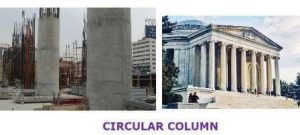
L- Type Column:-
They are generally used in the corners of the boundary wall and has same features of a rectangular or square column. These kind of columns are very less used.
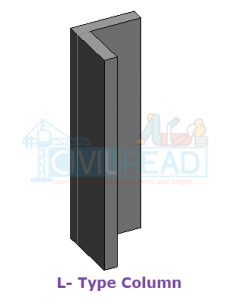
T- Type Column:
This kind of columns is used depending on design requirements and in the construction of bridges, etc. This has same features of a rectangular or square column.
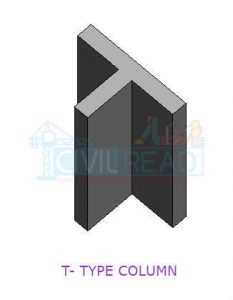
V- Type Column:-
As a name itself, it showcasing the column is in V shape and generally used if the shape of the room is in trapezoidal. As it requires more amount of concrete when compared to the other columns.

Hexagon Column:-
Hexagon columns are generally modified columns. It has six sides and it gives good pictorial view generally used in elevation. It is adopted to give a good look to the column. It is generally provided in open verandahs, Auditoriums, Cinema halls etc.
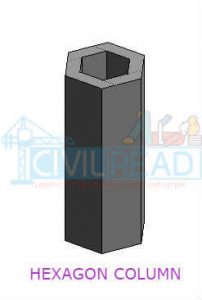
Arch type columns:
These type of columns are used when the room has a shape of an arch. It is adopted where there is a no chance of building square or rectangular or circular type of column. it is rarely used as it possess very difficulty in casting.
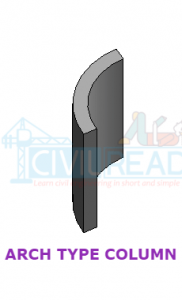
Y – Type Column:-
These types of columns are generally used in the construction of bridges, flyovers, etc.
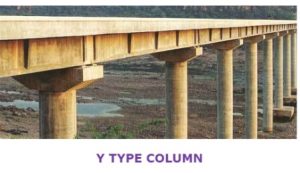
Y type Column with Arch:
As it is same as Y-type Column but it has curved edges or sides. These are generally provided below the bridges and flyovers where there is a congestion of building more columns to withstand heavy loads on top.
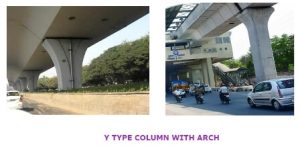
Based on Type of Reinforcement:-
Depending upon the type of reinforcement used, reinforced columns are classified into following types:-
Tied Column:
When the main longitudinal bars of the column are confined within closely spaced lateral ties, it is called as tied column.
Spiral Column:
When the main longitudinal bars of the column are enclosed with in closely spaced and continuously wound spiral reinforcement, it is called as a spiral column.
Composite Column:
When the longitudinal reinforcement is in the form of structural steel section or pipe with or without longitudinal bars, it is called as a composite column.
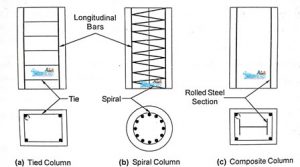
Based on the type of loading:-
Depending on the type of loading on columns are classified into three types:
Axially loaded Column: –
When the line of action of the compressive force coincides with the center of gravity of the cross-section of the column, it is called axially loaded column. (The total load from top is acted on the centroid of the column.) How to design Learn more
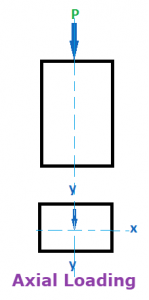
Eccentrically loaded column (Uniaxial or Biaxial):
When the line of action of compressive force doesn’t coincide with the center of gravity of the cross-section of the column, it is called as the eccentrically loaded column.
Uniaxial:
We know the X-Axis and Y-axis if load is acted eccentrically either on X or Y axis (anyone) then it is called as Eccentrically loaded column (uniaxial)
Biaxial:
If load is not acting eccentrically on both the axis, that mean load won’t act on either X or Y axis is called Eccentrically loaded column (Biaxial)
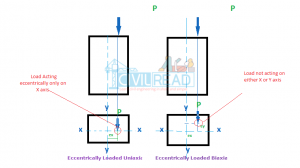
Based on Slenderness Ratio:-
Depending upon the Slenderness ratio (ratio of effective length to least lateral dimension of the column), the columns are classified as (most important)
It is used extensively for finding out the design load as well as in classifying various columns in short/intermediate/long.
Short Column:
If the ratio effective length of the column to the least lateral dimension is less than 12, the column is called as the short column. A short column fails by crushing (pure compression failure).
Long Column:
If the ratio effective length of the column to the least lateral dimension exceeds 12, it is called as long column. A long column fails by bending or buckling.
Some other types:
Stub Column/ Floating column / Linked Column:-
We know that column stands on the footing. but when coming to the stub column. It won’t have any footing. The column stands on the slab or beam.
For making you clear, here I am giving an example, for suppose you constructed a house with a capacity of 50 members so according to the members using building you design a water tank. Suddenly due to the scarcity of land building is using by 90 members so initially, you are provided one tank which will sufficient to 50 members. Now, you have to provide another tank to cover all the 90 members. But you constructed a building with the design of only one tank but additionally, another tank is added inorder to bear that load another column is added beneath the tank and it rests on either beam or column.
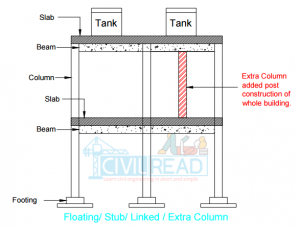
Neck column:
It is a part of the column (any type of column) which is buried in earth is called Neck column. The word Neck column is usually used while building footings.
 Hi, friends hope I covered each and every column. Found anything missed add them in comments will definitely add in this. Hope you learned everything about columns.
Hi, friends hope I covered each and every column. Found anything missed add them in comments will definitely add in this. Hope you learned everything about columns.Also Read: Learn Different Types of Footings
16 Different types of slabs used in construction
STAY TUNED MANY MORE ARE YET TO COME SOON!
For Instant updates-Join our Whatsapp Broadcast. Save our Whatsapp contact 9700078271 as Civil Read and Send us a message “JOIN”
Never Miss an Update Click on “Allow us” or Red notification bell at bottom right corner and allow notification. Stay tuned! More are updated Soon!!.
Civil Read Wishes you ALL the BEST..!


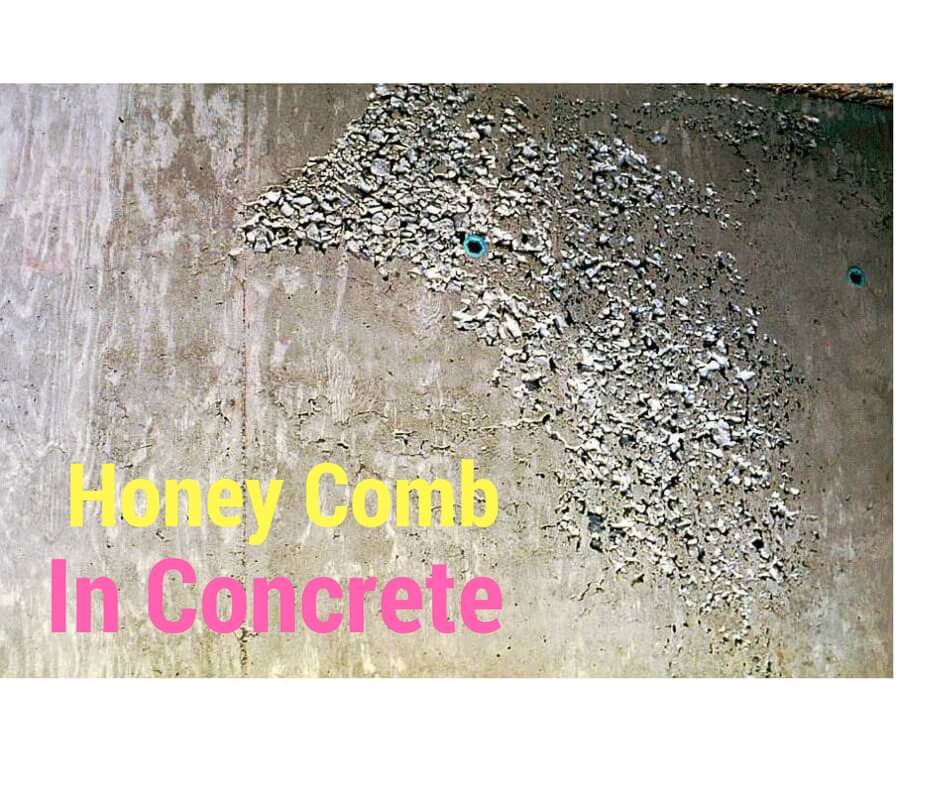

Your site is well made
I study all the articles
Can I join you as buisness partener in website , I can invest little amount
I am civil engineer with 10 years experience
I made a construction website but not operating as I dont have web experience
Which type of reinforcememt used in ptestresse concrete?
really this site is very useful for every CE student
Really felt very useful. Completely clear with the topic. Thanks a lot. Great author
Thank’s a lot gave it the useful examples and some information sir……
It’s got really good material! It’s a great help just before the exams! Thank you…
thanks for ur comments.
It’s really a useful website for Civil engineering.
Yh,we wnt these typs of infrmtn’s actually.
Thnq,sir
We generally use HYSD bars as there are significant losses in prestressed concrete.
Thanks for the details of columns
Its very usefull wbst for CE
very useful website having a very brief and clear explanation about the topic ,thanks a lot for such a website MR.KRISHNA
Nice bro its really usefull
I am planning to construct my second home. Your article found very useful to me.
Hello, I’m currently doing an assignment for school. It asks to identify certain columns in my schools building turns out there are 2 my instructor said. One is the square type of column and the other one is some sort of metal type. Is there a type of thin metal columns? this is for a walkway by the way. 🙂
This is a very helpful platform, thanks papa keep it up
bro, is leveling column and neck column are same?
The sight is v important for all CE & student!
It is a good idea of column& type
Please give the differences of OPC and PPC cement
Hi,
Thank you for your valuable topics. But can you guide me through the topic of discontinuous columns ? Also, in certain cases, if I want to reduce the column sizes in the upper floors, what is the reinforcement details and connections to the lower and larger columns below ?
Hey buddy post your query with more details on our forum visit https://forum.civilread.com
What is a “Carried Column”?
very good
Dear Krishna Sir,
your thought & Guidance is too useful as well as this Platform having a very brief and clear explanation about the topic.
Thanks a lot for such a website civil Read..
Dear Sir,
Please Explain some Thumb rule of calculation with Percent wise cost of any Industrial Project. Like…
1- Cost of Excavation value in % of whole project.
2- Cost of RCC work in %.
3- Brick work %
4- Steel Requirement etc. ?